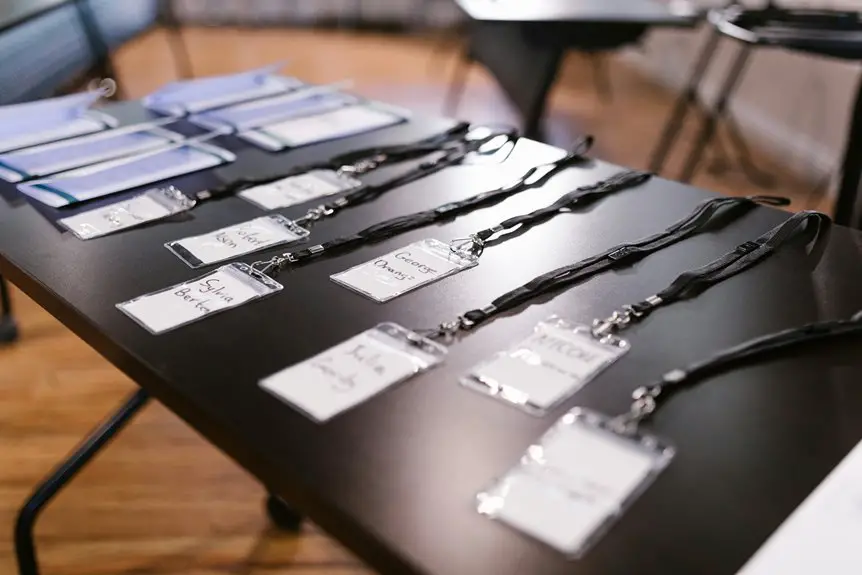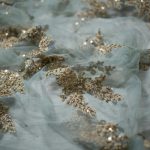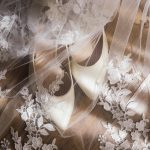You can spot Guipure lace by its bold, raised patterns connected through bars or plaits—notice there’s no net background like in other laces. It feels sturdy and textured, with thick outlines forming floral or geometric motifs. Compared to Chantilly’s delicate, fine look or Alençon’s sheer tulle base, Guipure stands out with its three-dimensional design. If you want to master lace identification and care, keep exploring these distinctive features and uses.
Table of Contents
Key Takeaways
- Guipure lace has bold motifs connected by bars or plaits, lacking any net or mesh background.
- It features thick, raised outlines that create a sturdy, three-dimensional texture.
- Compared to Chantilly lace, Guipure is heavier and more graphic, while Chantilly is delicate and fine.
- Unlike Alençon lace, Guipure lacks a sheer tulle base and has more robust, interconnected patterns.
- Authentic Guipure is made from high-quality cotton or silk threads with visible ornate motifs and dense stitching.
The Origins and History of Guipure Lace
Though guipure lace is often admired for its delicate beauty, you mightn’t realize it has a rich history dating back to 16th-century Europe.
You’ll find that this lace style originated in Italy before spreading to France, where it became especially popular.
Back then, guipure lace was handcrafted using thick threads to create bold, raised patterns, making it stand out from other lace types.
As you explore its history, you’ll see how it evolved alongside fashion trends, becoming a favorite for decorating garments and home textiles.
Understanding its origins helps you appreciate why guipure lace carries such cultural and artistic significance, setting it apart from more delicate or machine-made laces that came later.
Defining Features of Guipure Lace
Understanding the history of guipure lace gives you a deeper appreciation for its unique characteristics. Guipure lace stands out because it connects motifs with bars or plaits rather than a net background. This absence of netting creates a bold, three-dimensional effect you’ll notice immediately. The lace often features floral or geometric patterns, with thick, raised outlines that make each design pop. It’s also sturdier compared to more delicate laces, making it perfect for statement pieces.
| Feature | Description |
|---|---|
| Motif Connection | Connected by bars or plaits |
| Background | No netting, open spaces |
| Design | Bold, raised floral/geometric motifs |
| Texture | Sturdy, three-dimensional feel |
These traits help you identify guipure lace at a glance.
Comparing Guipure Lace to Chantilly Lace
You’ll notice Guipure lace has a heavier, more textured design compared to the delicate, fine patterns of Chantilly lace.
Each type serves different styles, with Guipure often used for bold, statement pieces and Chantilly favored for elegant, intricate details.
Understanding these differences helps you choose the right lace for your project or outfit.
Design and Texture Differences
When you compare Guipure lace to Chantilly lace, you’ll notice clear differences in their design and texture. Guipure lace features bold, interconnected patterns without a net background, giving it a raised, three-dimensional feel. On the other hand, Chantilly lace boasts delicate, fine floral motifs set against a sheer, netted base, making it appear lighter and more intricate. These characteristics affect both the look and tactile experience of the lace.
| Feature | Guipure Lace |
|---|---|
| Pattern Style | Bold, connected motifs |
| Background | No net, solid motifs |
| Texture | Thick, raised, three-dimensional |
| Appearance | Heavy, dramatic |
| Feature | Chantilly Lace |
| Pattern Style | Fine, detailed floral motifs |
| Background | Sheer net base |
| Texture | Soft, delicate |
| Appearance | Light, elegant |
Common Uses and Styles
Both Guipure and Chantilly lace serve distinct purposes in fashion and décor, catering to different styles and occasions.
When you choose Guipure lace, you’re opting for bold, statement pieces—think bridal gowns with dramatic floral patterns or elegant table runners that add texture and luxury. Its thicker, embroidery-like design makes it ideal for standout accents.
On the other hand, Chantilly lace offers delicate, intricate designs perfect for romantic, vintage-inspired looks. You’ll find it in veils, evening dresses, or lingerie where you want subtle elegance and softness.
Understanding these differences helps you pick the right lace for your project—Guipure for bold, textured impact; Chantilly for delicate, refined beauty.
Both add sophistication, but your style and occasion guide the best choice.
How to Differentiate Guipure From Alençon Lace
You’ll notice Guipure lace stands out with its bold, connected patterns, while Alençon lace features delicate floral motifs outlined with fine cordonnet.
Pay attention to their construction—Guipure lacks a net background, giving it a heavier, textured feel compared to the sheer, smooth base of Alençon.
Understanding these design and texture differences helps you tell them apart quickly.
Design Characteristics Comparison
Although Guipure and Alençon lace may look similar at a glance, you can tell them apart by examining their design features closely. Guipure lace is known for its bold, interconnected motifs without a net background, while Alençon lace features delicate floral patterns outlined with a fine cordonnet on a sheer tulle base. Here’s a quick comparison to help you distinguish them visually:
| Feature | Guipure Lace |
|---|---|
| Motif Style | Large, bold, connected |
| Background | No net, open spaces |
| Outline | Thick, raised |
| Pattern Complexity | Less delicate, geometric |
| Overall Appearance | Heavier, more graphic |
Focus on these design traits, and you’ll easily spot the difference between Guipure and Alençon lace.
Construction and Texture Differences
While design features help you recognize Guipure and Alençon lace at a glance, their construction and texture offer even clearer clues.
Guipure lace is made by connecting motifs with thick, raised threads, giving it a bold, three-dimensional texture that feels sturdy and slightly coarse.
In contrast, Alençon lace features a delicate net background called “fond tulle,” with intricate motifs outlined by fine cordonnet threads, creating a smoother, softer texture.
When you run your fingers across Guipure, you’ll notice its open, lace-like bridges and heavier weight, whereas Alençon feels lighter and more refined due to its sheer base fabric.
Recognizing the Motifs and Patterns in Guipure Lace
Understanding the motifs and patterns in Guipure lace helps you identify its unique artistry. When you look closely, you’ll notice Guipure lace features bold, often floral or geometric motifs that stand out distinctly.
These designs aren’t delicate or tiny; instead, they’re large and well-defined, creating a striking visual impact. The motifs connect directly to each other without any netting in between, giving the lace a heavier, more textured appearance.
You’ll often see repeated patterns that maintain symmetry and balance, enhancing the lace’s ornamental appeal. By focusing on these strong, interconnected designs, you can distinguish Guipure lace from other lace types that rely on finer, mesh-like backgrounds or more intricate, delicate motifs.
Recognizing these visual cues makes identifying Guipure lace much easier.
The Role of Bars and Plaits in Guipure Lace Design
When you examine Guipure lace closely, the bars and plaits play a crucial role in shaping its structure and appearance.
These connecting threads link the lace motifs without a net background, giving Guipure its distinctive open and airy look. The bars are typically thick and sturdy, providing strength while maintaining flexibility.
Plaits, on the other hand, are twisted or braided threads that add decorative detail and texture to the lace. Together, bars and plaits form a network that holds the motifs in place, emphasizing the lace’s bold, three-dimensional quality.
Common Uses and Applications of Guipure Lace
Guipure lace finds its way into a variety of fashion and decor applications thanks to its bold texture and open design. When you choose Guipure lace, you add a statement piece to bridal gowns, evening wear, and high-fashion outfits.
Its distinctive patterns and sturdy structure make it perfect for overlays, sleeves, and collars, where you want lace to stand out without being too delicate.
Beyond clothing, you’ll often see Guipure lace in home decor, like table runners, curtains, and decorative pillows, adding an elegant, handcrafted touch.
Since it holds shape well, you can also find it in accessories such as scarves, gloves, and even handbags.
Using Guipure lace lets you blend intricate artistry with lasting durability in your projects.
Tips for Authenticating Guipure Lace
Authenticating Guipure lace involves a few key steps that can help you distinguish it from other lace types.
First, examine the lace’s structure: Guipure lacks a net background and connects motifs with thick, embroidered bars or plaits.
Feel the texture—Guipure often feels heavier and more raised than delicate, flat lace varieties.
Check the edges; authentic Guipure typically has well-defined, ornate motifs with visible outlining threads.
Use a magnifying glass to look closely at the stitching; genuine Guipure shows consistent, dense embroidery without loose threads.
Finally, consider the material—traditional Guipure often uses high-quality cotton or silk threads.
Care and Maintenance for Guipure Lace Garments
Because delicate embroidery and intricate bars form the foundation of guipure lace, you’ll need to handle these garments with extra care.
Always opt for hand washing your lace in cold water with a mild detergent to prevent damage. Avoid wringing or twisting; instead, gently press out excess water and lay the garment flat on a clean towel to dry.
Keep guipure lace away from harsh sunlight and heat sources to prevent fading and weakening of fibers.
When storing, fold the garment carefully and place it in a breathable cotton bag or wrap it in acid-free tissue paper to maintain its shape and prevent snagging.
You’ll also want to avoid hanging guipure lace for long periods, as this can stretch the delicate fabric and distort its intricate patterns.
Frequently Asked Questions
Where Can I Buy High-Quality Guipure Lace?
Did you know 70% of luxury designers prefer guipure lace for its intricate patterns? You can buy high-quality guipure lace from specialty fabric stores, online marketplaces like Etsy, or directly from European lace manufacturers known for craftsmanship.
What Is the Average Cost of Authentic Guipure Lace?
You’ll find authentic guipure lace typically costs between $15 and $50 per yard, depending on quality and intricacy. Higher-end pieces can be pricier, so shop carefully to get the best value for your project.
Can Guipure Lace Be Dyed Different Colors?
You’d think guipure lace could swallow any color whole—it absolutely can be dyed! Just remember, since it’s thick and textured, you’ll want to test small spots first to guarantee vibrant, even hues without damage.
Is Guipure Lace Suitable for Machine Washing?
You shouldn’t machine wash guipure lace because it’s delicate and can easily get damaged. Instead, hand wash it gently with mild detergent to keep its intricate patterns intact and maintain its quality over time.
Are There Any Modern Designers Specializing in Guipure Lace?
If you’re looking to hit the nail on the head with guipure lace, designers like Elie Saab and Zuhair Murad specialize in it. You’ll find their modern creations beautifully showcase this intricate lace’s charm.
- Does Chiffon Fabric Stink - July 15, 2025
- Does Chiffon Fabric Affect the Economy - July 15, 2025
- Does Cotton Fabric Have a Nap - July 15, 2025







